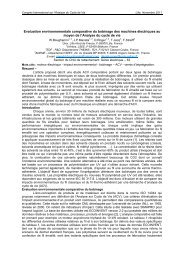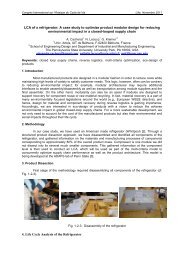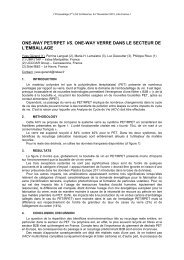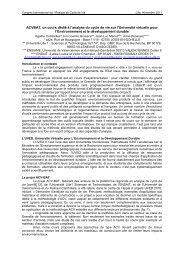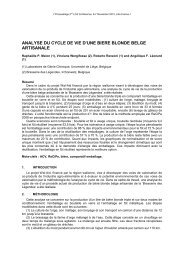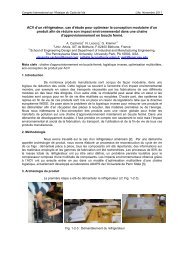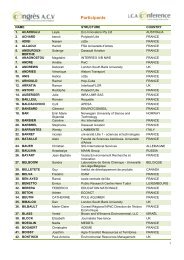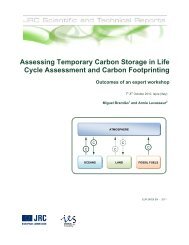Untitled - avniR
Untitled - avniR
Untitled - avniR
You also want an ePaper? Increase the reach of your titles
YUMPU automatically turns print PDFs into web optimized ePapers that Google loves.
Maturity of the requested<br />
report<br />
Boundaries<br />
Maturity<br />
Suitable for<br />
companies<br />
Congrès International sur l’Analyse du Cycle de Vie Lille, Novembre 2011<br />
Multi-criteria analysis of carbon footprint methods and initiatives:<br />
a first step toward life cycle management<br />
Naeem ADIBI 1 ,* and Stéphane MOREL 2, 3<br />
1 Platform [<strong>avniR</strong>] cd2e, Base of 11/19, 62750 Loos en Gohelle France<br />
2 Renault, Environmental Planning Strategy, Guyancourt, France<br />
3<br />
PhD Student, CGS (Centre de Gestion Scientifique), MINES ParisTech<br />
* n.adibi@cd2e.com<br />
Keywords: life cycle, carbon footprint, greenhouse gas emissions, prioritize<br />
Introduction:<br />
For companies with an international dimension, it is a necessity to manage environmental impacts<br />
of its activities directly and through the life cycle of its products. This vision gives them a control of<br />
regulatory and financial risk related to energy and material prices and finally an opportunity for<br />
differentiation by representing eco-designed products. Life Cycle Analysis is the most recognized<br />
methodology for measuring the impact of a product. By the way, to engage a company and its employees<br />
in order to cover all of its activities, carbon footprint quantification seems essential.<br />
Indeed, an exhaustive carbon footprint inventory allows representing both energy dependence and<br />
climate change impacts (Greenhouse Gases (GHG)) throughout the life cycle. The use of the carbon<br />
footprint in this context is a tool to define, categorize and prioritize reduction pathways.<br />
First of all this study aims to identify methods and initiatives. Then an evaluation grid is set up<br />
according to the relevance to business, completeness of all phases of life cycle and an overall assessment<br />
of quality. Finally, results give us the possibility to prioritize the different approaches.<br />
Method: Multi-criteria analysis:<br />
In this study, more than 60 methods of carbon footprints were enumerated in the world. According<br />
to their international reach, adoption and acceptance 15 are retained and are subjected to a multi-criteria<br />
analysis, including GHG Protocol, CDP, ISO 14064, Bilan Carbone, etc.<br />
The goal is to distinguish a rational approach that will best fit businesses and activities. Detailing<br />
strengths of each method, we will go further looking combination of methods:"hybrid method" idea.<br />
The three main criteria are: 1-Relevance to business; 2-Exhustivity of boundaries; 3-Quality of the<br />
requested report.The three main criteria are divided into sub-criteria with a rating system, "a, b, c, d,"<br />
according to level of performance and validity of explicit boundaries (scope 1, 2 or 3) as detailed in the<br />
next table.<br />
Table 1 Multi-criteria scoring grid<br />
Criterion<br />
Performance<br />
Cover private sector, public sector or<br />
both?<br />
Both Public or Private Other n/a<br />
The sector-specific guides Yes no<br />
Many organizations covered 10000< 2000-10000 1000-2000 1000><br />
GHGs covered Kyoto >Kyoto 'basket of six'



